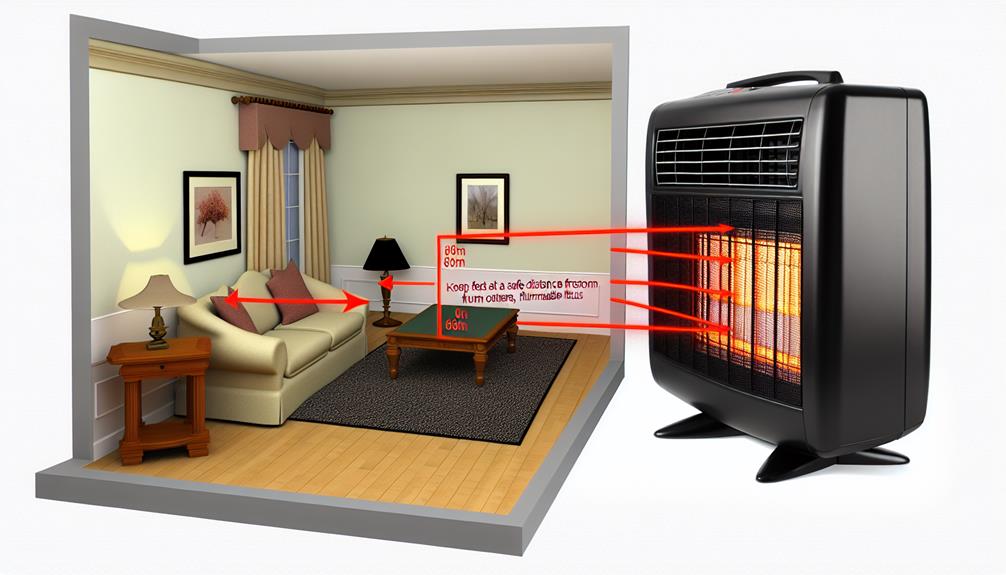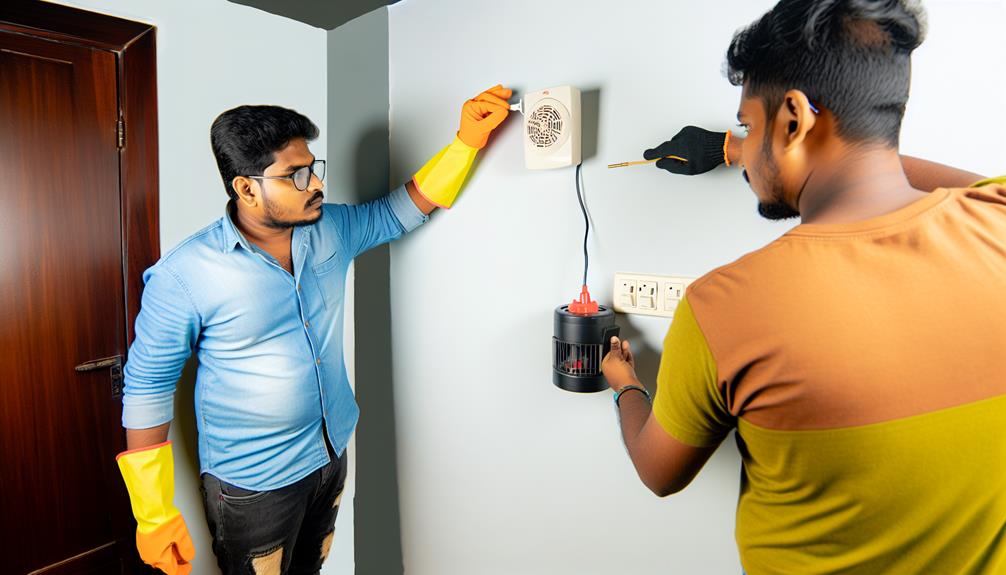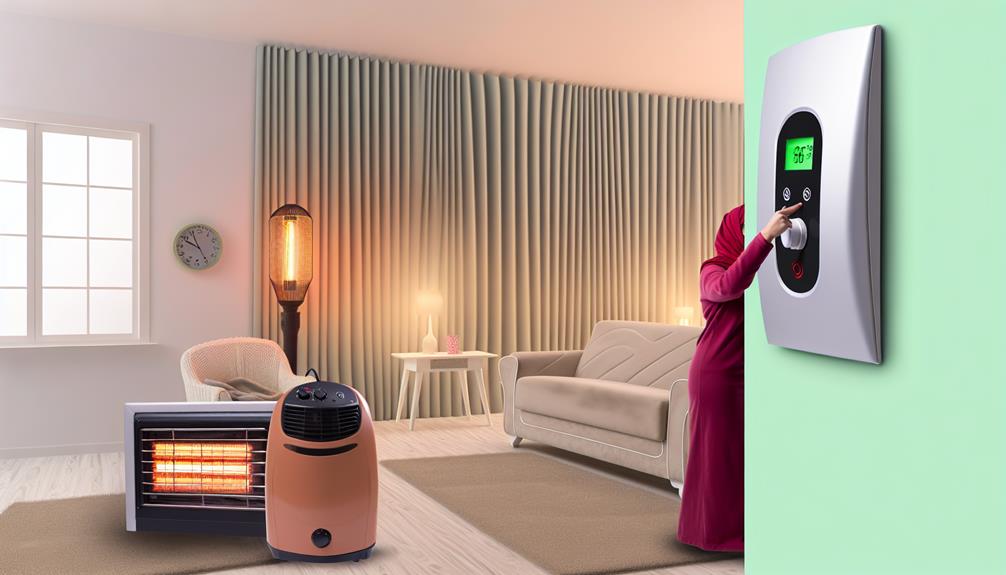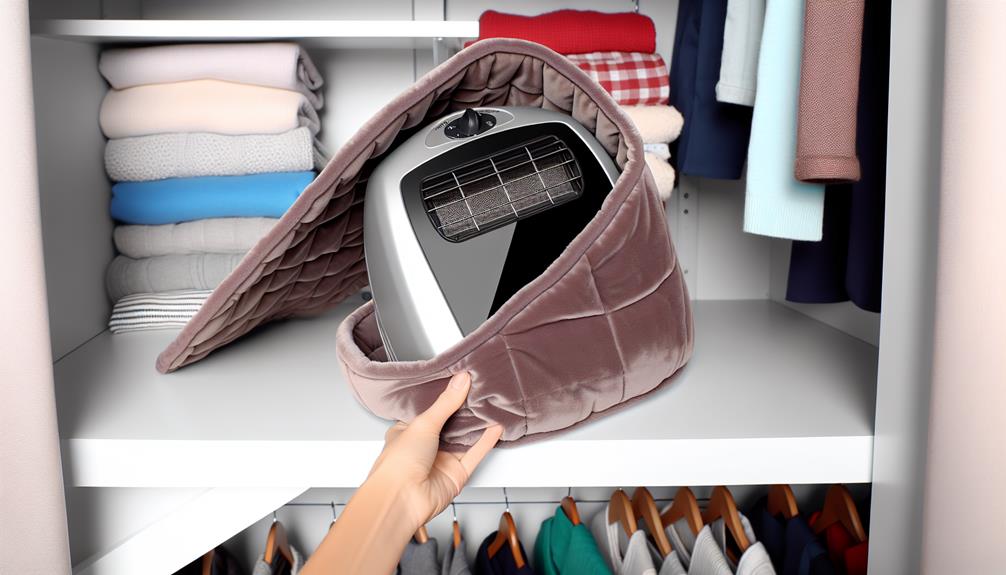Just as a captain steers a ship through icy waters with a keen eye on the compass, you must navigate the use of your portable heater with precision and understanding to ensure a warm but safe harbor at home. You've likely invested in this compact source of warmth for those nippy evenings or frost-touched mornings, seeking comfort without cranking up the central heating. However, while portable heaters can be a blessing, they demand respect and caution; misuse can lead to accidents, or worse, disasters. You don't want to learn safety protocols the hard way, so it's crucial to arm yourself with the right knowledge. As you look around your cozy room, consider this: are you aware of the intricacies that come with operating your heater safely? Stay with me, and you'll discover tips and guidelines that could not only save energy and money but perhaps even lives.
Key Takeaways
- Prioritize safety by selecting a portable heater with built-in safety features and certifications from independent testing organizations.
- Proper placement of the heater is essential, including maintaining a distance from combustible materials, high traffic areas, and unstable surfaces.
- Regular maintenance and upkeep, such as inspecting the cord, testing safety features, and using surge protectors, are necessary to ensure safe operation.
- Follow operating precautions, such as keeping the heater away from flammable items, creating barriers for children and pets, and never leaving the heater unattended or using extension cords.
Selecting the Right Heater
When choosing a space heater, it's crucial to prioritize safety by selecting a model with built-in features like tip-over switches and overheating sensors. As you deliberate on the type of space heater that will best suit your needs, methodically assess the safety features that accompany each potential purchase. Look for a safety certification label from an independent testing organization, as endorsed by the Consumer Product Safety Commission. This label is a testament to the heater's compliance with established safety standards.
As you prepare to use a space heater, consider models equipped with a ground-fault circuit interrupter (GFCI) plug. This feature offers an additional layer of protection, especially in areas where the risk of electrical accidents is heightened. Examine the cord of the heater you buy to ensure its sturdiness and appropriate length, as a cord that's too long can become a tripping hazard and may even overheat.
Heaters without proper safety credentials should be avoided. Always scrutinize the instructions and warning labels provided with your space heater. These labels contain critical information that will guide you in the safe operation of your device. Lastly, check the heater's fire safety score and hot-surface score to gauge its overall safety profile before making your final decision.
Understanding Safety Features
Having selected a space heater with essential safety features, it's important to understand how these mechanisms, such as tip-over switches and overheating sensors, actively contribute to your protection. When using space heaters, these integral components ensure that if your heater is accidentally knocked over or starts to overheat, it automatically shuts off, mitigating the risk of a fire. Space heaters are responsible for many home heating fires because users often leave a space heater unattended or misuse the device. Understanding and following safety features can drastically reduce these risks.
Here's a numeric list to help you familiarize yourself with essential safety aspects:
- Tip-Over Switches: If the heater tilts or falls, this feature breaks the electrical circuit, turning the heater off to prevent potential hazards.
- Overheating Sensors: These detect excessive heat within the heater's components. If temperatures exceed safe levels, the sensor triggers an automatic shutdown to avert overheating.
- GFCI Plugs: These plugs can prevent electric shock, especially in damp areas. They cut off power if an imbalance in electrical current is detected.
Proper Placement Guidelines

To ensure your space heater operates safely, always maintain a minimum distance of three feet from combustible materials such as paper, clothes, and rugs. Adhering to proper placement guidelines reduces the risk of fire hazards and enhances safety. Place your space heater at least three feet away from high traffic zones and doorways to avoid tripping. It's critical to keep it clear of children or pets to prevent accidental tipping.
Ensure the space heater is positioned on a stable surface, which means flat, level ground rather than on furniture or carpet that could catch fire. A tipover switch feature on your heater adds an extra layer of protection by automatically shutting it off if it falls over.
Never leave a space heater unattended or in use while you sleep. Unplug it when not in use to mitigate any potential risks. Here's a quick reference table for safe heater placement:
| Safe Placement Rule | Purpose | Additional Tips |
|---|---|---|
| At least three feet away | Prevents fires | Clear area of flammables |
| Away from traffic | Reduces tripping | Consider cord placement |
| Direct wall outlet | Avoids overheating | No extension cords |
| On stable surface | Prevents tipping | No tables/furniture |
| Unattended usage | Fire prevention | Always unplug after use |
Maintenance and Upkeep
Regularly inspecting the heater cord for signs of wear or damage is a crucial step in maintaining your portable heater's safety and functionality. Unlike central heating, electric space heaters require close attention to ensure they operate safely. You should unplug your heater when it's not in use, both to conserve energy and to prevent any potential safety hazards.
Here are key maintenance and upkeep steps to follow:
- Check and Test Safety Features: Ensure that the heater's safety features, like tip-over switches and overheating sensors, are functioning correctly. Heaters should also have a safety certification label from a recognized testing organization.
- Smoke Alarm Maintenance: Install working smoke alarms on every level of your home and test them monthly. This is a critical precaution that can save lives in the event of house fires.
- Electrical Precautions: Use a surge protector to guard against electrical surges and avoid plugging other devices into the same outlet as your heater. This reduces the risk of overloading circuits and causing a fire.
Operating Precautions

While maintaining your portable heater is crucial for safety, it's equally important to operate it with caution to minimize risks. Always position your portable heater on a stable, hard surface that's nonflammable. This methodical approach ensures the unit won't tip over, potentially causing a fire or other hazards.
Be diligent about the heater's proximity to combustibles; keeping it at least 3 feet away from items such as curtains, furniture, and bedding can prevent fires. It's also analytical to create a barrier, keeping them away from pets or children, to avoid burns or other injuries. Always turn off the space heater unattended, especially before leaving a room or going to bed. This detailed precaution can significantly reduce the risk of accidents.
Regularly inspect the cord for damage to prevent electric shock, and unplug the heater when it's not in use to conserve energy and enhance safety. It's crucial to never use extension cords with portable heaters, as they can overheat and lead to fire hazards. Lastly, ensure that smoke alarms are functional and tested monthly, to alert you promptly in the event of an emergency.
Child and Pet Safety
Ensuring the safety of children and pets around portable heaters requires a careful strategy, including the use of protective barriers and constant supervision. When you're dealing with children or curious pets, it's crucial to keep them away from the heat source to prevent accidents. Here are some methodical steps to take:
- Placement Matters: Make sure you place the heater on a flat, stable surface where it won't be easily knocked over. This minimizes the risk of it becoming a hazard.
- Establish Boundaries: Use safety gates or barriers to create a physical distance between the heater and young children or pets, maintaining a clearance of at least 3 feet on all sides.
- Supervise and Educate: Never use a portable heater without proper supervision. If you must leave the room, even for a short period, turn the heater off. Additionally, educate older children about the dangers of touching or playing near the heater.
Energy Efficiency Tips

To maximize your portable heater's energy efficiency and reduce your utility bills, select a model with a high energy-efficiency rating and built-in thermostat. When you use the heater, ensure it's in a location that promotes the distribution of warm air without obstruction, which allows you to stay warm more effectively during cold weather.
Be analytical about how you operate your space heater. Methodically adjust the thermostat to maintain a comfortable temperature rather than cranking it up to high, which can lead to unnecessary energy use. Detailed consideration of when and where you use the heater can lead to significant savings. For instance, only heat the portable space you're actively using, rather than trying to warm unoccupied rooms.
Emergency Protocols
As you focus on the energy efficiency of your portable heater, it's equally critical to establish clear emergency protocols for safe operation. Remember, while space heaters can provide additional warmth, they are also a leading cause of home fires, especially when not used with caution. Here are methodical steps to ensure you're prepared in case of an emergency:
- Install Smoke Alarms: Ensure you have smoke alarms on every level of your home and test them monthly. In the event of a fire, these alarms can provide the vital early warning needed to safely evacuate.
- Maintain Safe Clearance: Always keep your space heater at least 3 feet away from anything that can burn, including upholstery, clothing, and curtains. This reduces the risk of fire, particularly in rooms where children or pets may inadvertently knock the heater over.
- Avoid Improper Power Sources: Never use an extension cord or power strip with your space heater, as they can overheat and cause a fire. Directly plug the heater into the wall outlet and inspect the cord regularly for any damage.
In addition to these precautions, have an evacuation plan that everyone in the household understands. Keep emergency numbers handy, and if your space heater malfunctions, turn it off and unplug it immediately. If you ever encounter a fire, prioritize getting everyone out safely and call emergency services. Never underestimate the importance of being analytical and detailed when it comes to the safety of your home and loved ones.
Seasonal Storage Advice

When transitioning your space heater into seasonal storage, first unplug it and let it fully cool to mitigate any risk of fire or damage. Once your portable heater is no longer emitting heat, conduct a thorough cleaning to ensure your home stays safe. Dust and debris accumulated over the winter months can be a fire hazard if left unattended. Methodically wipe down the exterior and vacuum any interior components that are accessible, adhering to the manufacturer's guidelines to avoid damaging the heater without proper maintenance.
Next, find an ideal location for storage. Your space should be dry and cool, shielded from direct sunlight and moisture to prevent any potential damage. It's also crucial to choose a well-ventilated area to store your supplemental heat source to prevent any buildup of fumes or gases.
Lastly, protect your space heater by storing it in its original packaging or by covering it with a soft cloth. This prevents scratches and keeps dust from settling on it during the off-season.
Here's a table summarizing the seasonal storage advice for your portable heater:
| Step | Detail | Reason |
|---|---|---|
| Cool Down | Ensure the heater is fully cooled | Mitigates fire risk |
| Clean | Remove dust and debris | Prevents fire hazards |
| Store | In a dry, cool, ventilated area | Avoids damage and fume accumulation |
Frequently Asked Questions
How Do You Use a Portable Heater Safely?
To use your portable heater safely, ensure proper heater placement on nonflammable surfaces and maintain clear ventilation. Regularly inspect the cord for damage and establish a maintenance routine. Implement childproofing tips to safeguard kids. Be vigilant about fire hazards, keeping the heater away from flammables. Also, avoid overloading circuits to prevent electrical issues. This methodical approach, focusing on details, will minimize risks and optimize your heater's safe operation.
Is It OK to Leave Portable Heater on All Night?
You shouldn't leave your portable heater on all night. It's crucial for sleep safety to avoid fire risks and carbon monoxide exposure. Overheating prevention is key; therefore, check your heater's thermostat settings before bedtime. Remember, proper ventilation is important to prevent a buildup of toxic gases. Also, turning off your heater can significantly reduce energy consumption. Always prioritize safety and plan ahead to stay warm without relying on continuous heater use.
What Are the Two Safety Measures for Portable Heaters?
You're balancing warmth and safety: Heater Placement away from flammables and Regular Inspection are key. Ensure it's out of kids' reach for Childproofing, and don't forget Ventilation's Importance to avoid fumes. Power Considerations prevent electrical hazards, while a Maintenance Routine tackles wear and tear. Lastly, familiarize yourself with Emergency Precautions. Methodically analyze each step, detailing the procedures to protect yourself from the invisible risks that come with portable heater convenience.
How Do You Use a Space Heater Effectively?
To use a space heater effectively, first ensure proper placement on a nonflammable surface. Integrate insulation to maintain energy efficiency, and utilize zone heating to warm specific areas. Regularly perform maintenance checks, keeping the unit clean and the cord intact. Set the thermostat to a comfortable level to avoid overuse. Lastly, explore heating alternatives like warm clothing or blankets, which can provide additional warmth without constantly relying on the heater.
